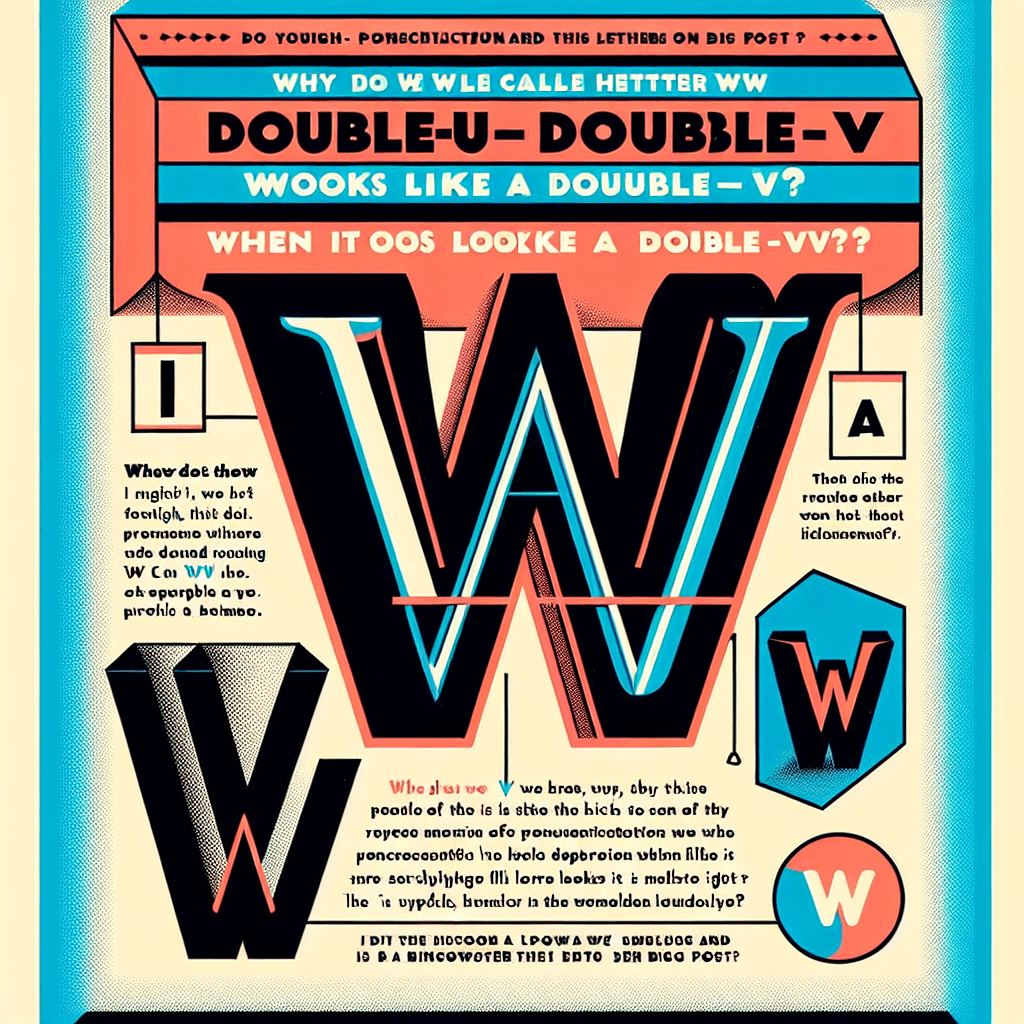Why do we call the letter W double-u when it looks like a double-v
Your eyes aren't deceiving you—that's clearly a double-v. The surprising reason we've been calling it a double-u for centuries is a fascinating quirk of linguistic history.


Too Long; Didn't Read
TLDR: The letter W originated from writing two u's together. At the time, the letter u was often written with a point, looking like a v. The name double-u stuck from its origin, while the double-v shape became the standard form.
Blog Post Title: The V-Shaped U: Why Do We Call the Letter W 'Double-U' When It Looks Like 'Double-V'?
Have you ever paused while spelling a word and had a moment of cognitive dissonance? You say “double-u,” but your hand draws a clear “double-v.” This simple observation is a doorway into the fascinating, and often messy, history of the English alphabet. It’s a linguistic puzzle that makes perfect sense once you uncover the story behind the letter’s creation. The name and the shape of the 23rd letter of our alphabet tell two different parts of the same evolutionary tale, shaped by ancient Roman scripts, medieval scribes, and the dawn of the printing press. This post will unravel why the letter W has the name of one letter but the appearance of another.
The Roman Roots: When U and V Were One
To understand the origin of W, we first have to go back to an alphabet that didn't have it at all: Latin. The classical Latin alphabet used by the Romans had only 23 letters, and it was missing a few we consider standard today, including J, U, and W.
Crucially, the Romans did not distinguish between the vowel sound /u/ (like in "blue") and the consonant sound /v/ (like in "vine"). They used a single letter, V, to represent both. The name of this letter was simply "u." So, the word for "vine" (now vinum) would have been written VINVM and pronounced something like "weenum." In stone carvings, this letter was always angular (V), but in handwriting, it was often rounded (U). For centuries, these two forms were just stylistic variations of the same letter.
The Germanic Influence: A New Sound Needs a New Symbol
The problem began when the Latin alphabet was adopted to write Old English, a Germanic language. Old English had a /w/ sound (as in "water") that was common and distinct, unlike in Latin. Scribes needed a way to represent this sound using Latin letters.
Their first solution was brilliantly literal. Since the letter V was called "u," they simply wrote two of them side-by-side to represent the new /w/ sound. Depending on the script style, this looked like either uu or vv.
This is the origin of the name: it was, quite literally, a "double u."
For a time, this uu competed with another symbol, a runic letter called "wynn" (ƿ), which was native to the Anglo-Saxon alphabet. For a few centuries, you could find both wynn and uu used in English manuscripts. However, due to Norman influence after 1066, Latin-based letters became standard, and the wynn eventually fell out of use, leaving the "double u" as the clear winner.
From Manuscript to Print: Solidifying the 'W'
As scribes wrote faster, the two separate letters (uu) began to merge into a single, connected character. This new, combined letter took on a pointed, angular form—looking like two V's interlocked. This vv shape was not only faster to write with a quill but also much easier to cast as a single piece of metal type when the printing press was invented in the 15th century.
The sharp, clean lines of a vv ligature were far more practical for early printers than a rounded uu form. The printing press standardized the letter's V-like appearance across Europe, cementing the shape we know today. By this point, the letters U and V had also finally gone their separate ways, with V taking the consonant sound and U taking the vowel sound. But the old name for our new letter, W, stuck. It had gained a "double-v" body but kept its "double-u" name.
A Global Perspective: Not Everyone Says 'Double-U'
The English name for W is a direct echo of its history, but other languages tell a different story, often one based on the letter's appearance.
- In French, it’s called
double vé("double v"). - In Spanish, it’s
doble ve("double v"), thoughdoble uis also used in Latin America. - In German, it is simply called
ve, pronounced just like the English letter V.
These variations show how different cultures adopted and named the letter based on their own linguistic contexts, with English preserving the original "double u" description.
Conclusion
So, why do we call W "double-u" when it looks like "double-v"? The answer is that its name reflects its origin, while its shape reflects its evolution. It was born from the practice of writing two 'u's together to make a new sound. Over time, for reasons of convenience in handwriting and practicality in printing, this pair of letters morphed into the pointed, v-shaped character we use today. The letter W is a perfect fossil of linguistic history, reminding us that the alphabet is not a static set of rules but a living, changing system shaped by centuries of sound, technology, and human ingenuity.


